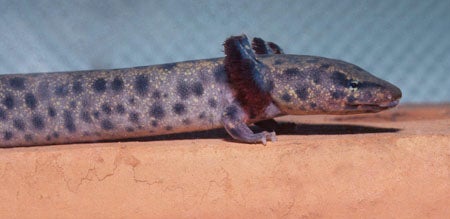SCIENTIFIC NAME:
Necturus beyeri
STATUS:
Uncommon to common in suitable habitats. Widespread in Mobile Bay drainage of Coastal Plain. Occurs in lower densities in Ridge and Valley and Piedmont, possibly due to habitat limitations. Similar in habits to Black Warrior waterdog, but may be less dependent on rocks and crevices for shelter. MODERATE CONSERVATION CONCERN.
DESCRIPTION:
The Gulf Coast waterdog is an aquatic salamander 6.25 to 8.75 inches in length. Ground coloration is dark brown, but may appear much lighter due to multiple tan spots that join to form a net-like pattern. The spots are irregularly shaped and arranged. Some specimens have a dark stripe through the eye. Juveniles are lighter, with small dull yellow spots that darken as the salamander matures. They have four toes on all four feet.
DISTRIBUTION:
Occurs from East Texas across the Gulf Coast states to Georgia and Florida. In Alabama, Necturus beyeriis primarily found in the Mobile Bay drainage. They are found in fewer numbers in the Ridge and Valley and Piedmont regions.
HABITAT:
These aquatic salamanders prefer sandy, spring-fed streams, but inhabit large rivers and standing backwater as well.
FEEDING HABITS:
They are opportunistic feeders that consume any small aquatic life form including fish, eggs, crayfish, aquatic mollusks and worms.
LIFE HISTORY AND ECOLOGY:
Very little is known about the life history of the Gulf Coast waterdog in Alabama. In other parts of the range courtship occurs in fall and winter. Fertilization is accomplished by spermatophores. Nesting occurs in April-June. Eggs are often deposited on the bottom surface of debris that offers protection from aquatic predators.
REFERENCES:
Conant, Roger. 1975. A Field Guide to Reptiles and Amphibians of Eastern and Central North America. Houghton Mifflin Co., Boston, MA. 442-443 pp.
Mirarchi, Ralph E. 2004. Alabama Wildlife Volume One: A Checklist of Vertebrates and Selected Invertebrates: Aquatic Mollusks, Fishes, Amphibians, Reptiles, Birds, and Mammals. The University of Alabama Press. Tuscaloosa, AL. 118 pp
Mount, Robert H. 1996. The Reptiles & Amphibians of Alabama. The University of Alabama Press. Tuscaloosa, AL. 144-145 pp.
AUTHOR: Matt Brock, Wildlife Biologist, Alabama Division of Wildlife and Freshwater Fisheries






